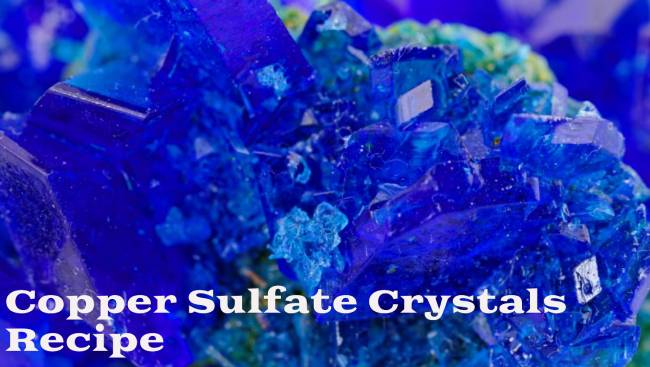Copper sulfate crystals are among the easiest and most beautiful crystals to grow. Brilliant blue crystals can grow relatively quickly and become quite large.

Table of Contents
Grow Copper Sulfate Crystals
- The copper sulfate crystals are vivid blue diamond-shaped crystals.
- Crystals of copper sulfate are actually crystals of copper sulfate pentahydrate. Water is incorporated into the structure of the compound.
- An inexpensive, common chemical can be used to grow the crystals.
Copper Sulfate Crystal Materials
Copper sulfate, water, and a clear container are all you need for this project. Although copper sulfate (CuSO4) is sold as a chemical, it readily becomes copper sulfate pentahydrate (CuS04. 5H20). You can purchase it as a pure chemical or find it as the only ingredient in root killer products at home supply stores.
- Sulfate of copper
- The water
- The jar
Make a Saturated Copper Sulfate Solution
Stir copper sulfate into very hot water until it no longer dissolves. The solution can be poured into a jar and left for a few days to crystallize, but if you grow a seed crystal, you can get a much larger and better-shaped crystal.
Grow a Seed Crystal
Take a small amount of the saturated copper sulfate solution and pour it into a saucer or shallow dish. Place it in an undisturbed location for several hours or overnight.
You should choose the best crystal as your ‘seed’ for growing a large crystal. Tie a nylon fishing line to the crystal after it has been scraped off the container.
Growing a Large Crystal
- Put the seed crystal in a clean jar filled with the solution you made earlier. Keep the jar from spilling undissolved copper sulfate. Keep the seed crystal away from the jar’s sides and bottom.
- Make sure the jar is placed in a location where it won’t be disturbed. In order to allow the liquid to evaporate, place a coffee filter or paper towel over the top of the container.
- Keep an eye on the growth of your crystal every day. When you see crystals growing on the bottom, sides, or top of the container, remove the seed crystal and suspend it in a clean jar. This jar should be filled with the solution. It is not a good idea to have extra crystals growing because they will compete with your crystal and slow it down.
- As soon as you’re satisfied with your crystal, you can remove it from the solution and let it dry.
It is best to grow the crystal in a stable temperature environment. Crystals are dissolved (warm) and deposited (cold) as a result of temperature fluctuations. A countertop is a better location than a sunny window sill, for example.
Copper Sulfate Tips & Safety
- Copper sulfate can cause irritation of the skin and mucous membranes if swallowed. Rinse the skin with water if it has been in contact with the substance. Water should be given if swallowed, and a physician should be contacted.
- Wear gloves if you intend to handle the crystals. Gloves protect your skin from irritation and intense blue stains. Durable nitrile examination gloves are the best ones for the job. They’re accessible and durable. Plus, they don’t contain latex, which can trigger allergic reactions in some people.
- Water temperature has a great impact on the amount of copper sulfate (CuS04. 5H20) that dissolves.
- If you want to store your finished copper sulfate pentahydrate crystal, keep it in a sealed container. As a result, water will evaporate from the crystals, leaving them dull and powdery from efflorescence. Copper sulfate anhydrous is the gray or greenish powder.
- In copper plating, blood tests for anemia, algicides and fungicides, textile manufacturing, and as a desiccant, copper sulfate is used.
- Municipal water utilities can handle copper sulfate if you dump it down the drain, but don’t let it go into the environment. Plants, invertebrates, and algae are toxic to copper sulfate.
